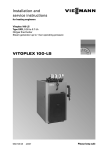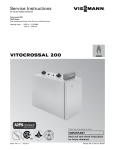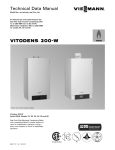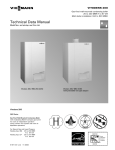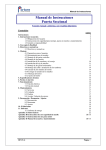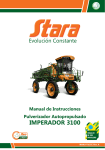Download Viessmann Vitola 200 Technical data
Transcript
Start-up/Service Instructions for use by heating contractor Vitola 200 VB2 Series Oil-/Gas-Fired Boiler Heating input 83 to 300 MBH 24 to 88 kW VITOLA 200 IMPORTANT Read and save these instructions for future reference. 5167 405 v2.2 04/2008 Safety, Installation and Warranty Requirements Safety, Installation and Warranty Requirements Please ensure that this manual is read and understood before commencing installation. Failure to comply with the issues listed below and details printed in this manual can cause product/property damage, severe personal injury, and/or loss of life. Ensure all requirements below are understood and fulfilled (including detailed information found in manual subsections). H Licensed professional heating contractor The installation, adjustment, service, and maintenance of this equipment must be performed by a licensed professional heating contractor. Please see section entitled “Important Regulatory and Installation Requirements.” " H Product documentation Read all applicable documentation before commencing installation. Store documentation near boiler in a readily accessible location for reference in the future by service personnel. H Contaminated air Air contaminated by chemicals can cause by-products in the combustion process which are poisonous to inhabitants and destructive to Viessmann equipment. For a listing of chemicals which cannot be stored in or near the boiler room, please see section entitled “Combustion Air Supply” in Installation Instructions. " H Carbon monoxide Improper installation, adjustment, service and/or maintenance can cause flue products to flow into living space. Flue products contain poisonous carbon monoxide gas. H Fresh air This equipment requires fresh air for safe operation and must be installed ensuring provisions for adequate combustion and ventilation air exist. For information pertaining to the fresh air requirements of this product, please see section entitled “Combustion Air Supply.” in Installation Instructions. " H Equipment venting Never operate boiler without an installed venting system. An improper venting system can cause carbon monoxide poisoning. For information pertaining to venting and chimney requirements, please see section entitled “Venting Connection” in Installation Instructions. All products of combustion must be safely vented to the outdoors. " For a listing of applicable literature, please see section entitled “Important Regulatory and Installation Requirements.” " WARNING Installers must follow local regulations with respect to installation of carbon monoxide detectors. Follow manufacturer’s maintenance schedule of boiler. H Warranty Information contained in this and related product documentation must be read and followed. Failure to do so renders warranty null and void. 5167 405 v2.2 H Advice to owner Once the installation work is complete, the heating contractor must familiarize the system operator/ultimate owner with all equipment, as well as safety precautions/ requirements, shut-down procedure, and the need for professional service annually before the heating season begins. For information pertaining to the proper installation, adjustment, service and maintenance of this equipment to avoid formation of carbon monoxide, please see sections entitled “Combustion Air Supply” and “Venting Connection” in Installation Instructions. " 2 Safety, Installation and Warranty Requirements Safety, Installation and Warranty Requirements (continued) Please ensure that this manual is read and understood before commencing installation. Failure to comply with the issues listed below and details printed in this manual can cause product/property damage, severe personal injury, and/or loss of life. Ensure all requirements below are understood and fulfilled (including detailed information found in manual subsections). H Fiberglass wool and ceramic fiber materials WARNING Inhalation of fiberglass wool and/or ceramic fiber materials is a possible cancer hazard. These materials can also cause respiratory, skin and eye irritation. The state of California has listed the airborne fibers of these materials as a possible cancer hazard through inhalation. When handling these materials, special care must be applied. Precautionary measures - Avoid breathing fiberglass dust and contact with skin and eyes. - Use NIOSH approved dust/mist respirator. - Wear long-sleeved, loose fitting clothing, gloves and eye protection. - Wash work clothes separately from other clothing. Rinse washer thoroughly. - Operations such as sawing, blowing, tearout and spraying may generate airborne fiber concentration requiring additional protection. H Hazardous materials WARNING Appliance materials of construction, products of combustion and the fuel contain alumina, silica, heavy metals, carbon monoxide, nitrogen oxides, aldehydes and/or other toxic or harmful substances which can cause serious injury or loss of life and which are known to the State of California to cause cancer, birth defects and other reproductive harm. Always use proper safety clothing, respirators and equipment when servicing or working nearby the appliance. First aid measures - If eye contact occurs, flush eyes with water to remove dust. If symptoms persist, seek medical attention. - If skin contact occurs, wash affected areas gently with soap and warm water after handling. 5167 405 v2.2 Suppliers of ceramic fiber products recommend the following first aid measures: - Respiratory tract (nose and throat) irritation If respiratory tract irritation develops, move the person to a dust free location. - Eye irritation If eyes become irritated, flush immediately with large amounts of lukewarm water for at least 15 minutes. Eyelids should be held away from the eyeball to ensure thorough rinsing. Do not rub eyes. - Skin irritation If skin becomes irritated, remove soiled clothing. Do not rub or scratch exposed skin. Wash area of contact thoroughly with soap and water. Using a skin cream or lotion after washing may be helpful. - Gastrointestinal irritation If gastrointestinal tract irritation develops, move the person to a dust free environment. Suppliers of fiberglass wool products recommend the following precautions be taken when handling these materials: 3 Contents Page Safety Important Regulatory and Installation Requirements General Information About these Service Instructions .... 5 ........................................ 6 ....................................................................... 6 ........................................................................... 7 ........................................................................................ 8 Necessary Tools Start-up and Service Additional Information Initial Start-up Service Parts List .................................................................................... ............................................................... 16 5167 405 v2.2 Maintenance Record 13 4 Safety Important Regulatory and Installation Requirements Instructing the system user The installer of the system is responsible to ensure the system operator/ultimate owner is made familiar with the system functioning, its activation, its shut-down, and the need for periodic service. Initial start-up Initial start-up must be performed by a qualified heating contractor; values and calibrations specified in the burner test sheet are to be verified at this time. Completion of the Maintenance Record by the heating contractor is also required. The following topics must be covered: Proper system operation sequence. Explain the equipment as well as the need for combustion air. Demonstrate an emergency shut-down, what to do and what not. Explain that there is no substitute for proper maintenance to help ensure safe operation. Working on the equipment The installation, adjustment, service, and maintenance of this boiler must be done by a licensed professional heating contractor who is qualified and experienced in the installation, service, and maintenance of hot water boilers. There are no user serviceable parts on the boiler, burner, or control. Ensure main power supply to equipment, the heating system, and all external controls has been deactivated. Close main oil or gas supply valve. Take precautions in both instances to avoid accidental activation of power during service work. Please carefully read this manual prior to attempting start-up, maintenance or service. Any warranty is null and void if these instructions are not followed. For information regarding other Viessmann System Technology componentry, please reference documentation of the respective product. We offer frequent installation and service seminars to familiarize our partners with our products. Please inquire. Leave all literature at the installation site and advise the system operator/ultimate owner where the literature can be found. Contact Viessmann for additional copies. 5167 405 v2.2 Technical literature Literature applicable to all aspects of the Vitola: - Technical Data Manual - Installation Instructions - Start-up/Service Instructions - Installation codes mentioned in this manual 5 General Information About these Service Instructions Take note of all symbols and notations intended to draw attention to potential hazards or important product information. These include ”WARNING”, ”CAUTION”, and ”IMPORTANT”. See below. WARNING Indicates an imminently hazardous situation which, if not avoided, could result in death, serious injury or substantial product/property damage. CAUTION Indicates an imminently hazardous situation which, if not avoided, may result in minor injury or product/property damage. IMPORTANT Warnings draw your attention to the presence of potential hazards or important product information. Cautions draw your attention to the presence of potential hazards or important product information. Helpful hints for installation, operation or maintenance which pertain to the product. This symbol indicates that additional, pertinent information is to be found in column three. This symbol indicates that other instructions must be referenced. Necessary Tools Special Items Approved leak detection fluid Testing/analysis equipment Flue gas analyzer Use only calibrated equipment. Cleaning supplies Hand brush Rags Vacuum cleaner Cleaning brush (Standard equipment) Technical information Operating Instructions of boiler and all accessories Parts List of each accessory 6 5167 405 v2.2 Parts Rope sealant for combustion chamber door Refractory for combustion chamber door Burner refractory for combustion chamber Start-up and Service Initial Start-up See Operating Instructions, Service Instructions of Power Burner and Boiler Control 1. Ensure combustion and ventilation air openings of boiler room are open and that chimney and all flue pipes are connected, sealed and unobstructed inside. Verify that all requirements in the Combustion Air Supply section of the boiler Installation Instructions are met. 2. Ensure proper operation of expansion tank (see Maintenance/Service manual). 3. Ensure that system piping is flushed out to remove debris and/or sludge. Failure to do so could cause settlement in the boiler causing overheating and damage not covered by warranty. 4. Fill heating system with water and bleed out air completely. Ensure complete system is properly vented of air. Max. system operating press. . . . . . . . . . . . . . . . . . . . . . . . . . . . . . . . . . . . . . . . . . . . . . . . . . . . . <30 psig Pressure relief discharge press. . . . . . . . . . . . . . . . . . . . . . . . . . . . . . . . . . . . . . . . . . . . . . . . . . . . . . . . . 30 psig 5. Perform a pressure test of the boiler and the water piping. Pressure test must not exceed 1½ times the maximum system operating pressure (45 psig ) of the boiler. Pressure relief valve must be removed during pressure test. Any leaks must be corrected. 6. Ensure fuel proper/adequate fuel supply exists; open oil or gas shut-off valve. WARNING 5167 405 v2.2 DO NOT USE GASOLINE CRANKCASE DRAININGS OR ANY OIL CONTAINING GASOLINE. WARNING Keep boiler clear and free from combustible materials, gasoline, and other flammable vapors and liquids. Do not obstruct the flow of combustion and ventilation air. If the nitrogen pressure of the precharged expansion tank is less than the static pressure of the system, inflate membrane pressure to slightly exceed pressure of system. The static pressure required at the tank is based upon the static height of the system. Water treatment should be considered in areas where it is known that boiler feed water contains a high mineral content and hardness. In areas where freezing might occur, an antifreeze may be added to the system water to protect the system. Please adhere to the specifications given by the antifreeze manufacturer. Do not use automotive silicate-based antifreeze. Please observe that an antifreeze/water mixture may require a backflow preventer within the automatic water feed and influence components such as diaphragm expansion tanks, radiation, etc. A 40% antifreeze content will provide freeze-up protection to -10°F / -23°C. Do not use antifreeze other than specifically made for hot water heating systems. System also may contain components which might be negatively affected by antifreeze. Check total system frequently when filled with antifreeze. 7. Verify completeness of all discussion points on the following pages in the section entitled Service before starting up system. 7 Start-up and Service Service 1. Shut down heating system 1. Ensure main power supply to equipment, the heating system, and all external controls has been deactivated. Take precautions in both instances to avoid accidental activation. 2. Close main gas or oil supply valve near burner (and near oil tank if applicable). WARNING Always keep the manual fuel supply valve shut off if the burner is shut down for an extended period of time. 2. Open combustion chamber door Illustration shows Viessmann Chassis Burner installed on Vitola 200 boiler. 1. Disconnect and remove burner hood (Viessmann Chassis burner only). 2. Disconnect from burner. plug-in connector IMPORTANT Disconnect gas supply piping if a gas burner is installed. Remove oil lines if an oil burner is installed. 3. Remove four bolts of combustion chamber door and open (hinge pin must remain inserted). WARNING 5167 405 v2.2 Never burn garbage or paper in the unit, and never leave combustible material around it. 8 Start-up and Service Service (continued) 3. Clean chimney, flue pipe and heat exchanger 1. Check flue pipe condition, chimney connection, and chimney itself, both inside and outside, for rust, deterioration, blockage, or leakage. Repair or replace as necessary. 2. Ensure combustion and ventilation air openings of boiler room are open and unobstructed. 3. Remove combustion chamber insert and clean. 4. Clean heat exchanger surfaces with the cleaning brush and using a vacuum cleaner. 4. Check all gaskets and insulation 1. Check all gaskets and the sealant rope of the combustion chamber door for wear or damage. 2. Check the combustion chamber door refractory and burner refractory for wear or damage. 5167 405 v2.2 3. Replace worn or damaged parts. 9 Start-up and Service Service (continued) 5. Close combustion chamber door 1. Push in combustion chamber insert as far as it will go. Handle must be at bottom. IMPORTANT The combustion chamber insert has a lip at the back. Push combustion chamber insert into combustion chamber so that lip slides into matching notch at the back of the combustion chamber. Failure to do so will damage door refractory when door is closed. 2. Close combustion chamber door and tighten four bolts in a cross-wise fashion. 3. Reconnect burner fuel line(s). 4. Mount burner hood (if applicable). WARNING Reconnect oil burner and follow instructions found in burner installation/start-up manual. WARNING For gas burner, perform necessary leak detection tests. 6. Check heating system and domestic hot water connections Ensure all connections are pressure tight. 7. Ensure proper operation of all safety devices Flush float type low water cut-offs (if used). If oil-lubricated pumps are used, ensure proper lubrication. 10 If motorized zone valves are used, check and service as necessary. Refer to manufacturer’s instructions for each of the components listed above. Follow local regulations with respect to backflow preventers. 5167 405 v2.2 Ensure proper operation of low water cut-off(s), pressure relief valve, and pump(s). Start-up and Service Service (continued) 8. Ensure proper operation of automatic fill valve and expansion tank; also ensure proper system water pressure IMPORTANT Check fill pressure when system is cold. Ensure proper operation of automatic fill valve and expansion tank. If a non-diaphragm expansion tank is used, ensure the correct water level is present (expansion tank should be 2/3 full). The usual water fill pressure is between 10 and 15 psi with the system cold. Check pressure gage on safety header. All leaks must be corrected. Refer to manufacturer’s instructions for each of the components listed above. CAUTION This boiler is not for use in systems where water is constantly or frequently replenished. Minerals such as calcium in make-up water can deposit on heat exchanger causing overheating, and eventually the boiler will leak. This type of failure is not covered by warranty. Water must not be drained from system for use by cleaning personnel. 9. Ensure enclosure panels are correctly fitted 1. Ensure all enclosure panels are seated properly; adjust as necessary. 2. Ensure strain reliefs on rear panel are tight and seated properly. 10. Ensure mixing valve(s) rotates easily and is pressure tight (if installed) 1. Remove mixing valve lever. 2. Check if mixing valve rotates easily. 3. Ensure mixing valve is pressure tight (does not leak). Replace O-Ring seals if necessary. 5167 405 v2.2 4. Reinstall mixing valve lever. 11 Start-up and Service Service (continued) 11. Ensure that an adequate combustion air supply exists in the boiler room Ensure fresh air intake of boiler room is open. This opening must never be blocked or partially covered. 12. Ensure functionality of the barometric draft regulator of the burner During operation of the burner, the barometric installed in the vent system must move freely. 13. Calibrate the burner Service Instructions Burner WARNING DO NOT START THE BURNER UNLESS THE COMBUSTION CHAMBER DOOR IS SECURED IN PLACE. CAUTION When the boiler is fired for the first time, the ceramic fiber insulation on the back of the combustion chamber door will require ½ to 1 hour to firing time to “cure.” An odor may occur during this time. Final measurements of CO must be done only after the “cure” is complete. WARNING DO NOT ATTEMPT TO START THE BURNER WHEN EXCESS OIL HAS ACCUMULATED IN THE COMBUSTION CHAMBER, WHEN THE UNIT IS FULL OF VAPOR, OR WHEN THE COMBUSTION CHAMBER IS VERY HOT. WARNING DO NOT USE GASOLINE CRANKCASE DRAININGS OR ANY OIL CONTAINING GASOLINE. 14. For systems subject to freezing temperatures 12 5167 405 v2.2 CAUTION If the system is subject to freezing temperatures and is not filled with antifreeze for protection, the system including the boiler must be drained of water. The valve before automatic feed valve (if installed) must be closed; all other valves, air vents, and drain valves must stay open. Additional Information Parts List Ordering Replacement Parts: Please provide boiler Model and Serial Number from rating plate when ordering replacement parts. Order replacement components from your Viessmann distributor. 008 Pressure vessel insulation blanket 009 2-Channel strain relief 010 8-Channel strain relief 011 Cover 015 Mounting bracket, rear 016 Mounting bracket, front 017 Edgemolding cover Boiler control, see separate Parts List Rating plate 5167 405 v2.2 Parts 001 Insulation jacket (entire insulation assembly) 002 Top panel 003 Front panel 004 Rear panel 005 Side panels right and left 006 Rear insulation blanket 007 Front insulation blanket 13 Additional Information Parts List (continued) Parts List 012 Combustion chamber door 013 Packing seal 014 Combustion chamber door refractory 032 Observation port cover 033 Rope seal 034 Door pin 018 Combustion chamber refractory 019 Flue gas collector (order 027 Sealant) 020 Combustion chamber insert 021 Boiler shell 025 Cleaning brush handle 036 Cleaning brush head Not illustrated 026 Insulation accessories 027 Flue outlet sealant 028 Spray paint, vitosilver 029 Touch-up pen, vitosilver 030 Installation Instructions 031 Start-up/Service Instructions 034 021 033 5167 405 v2.2 032 14 Additional Information 5167 405 v2.2 Notes 15 Additional Information Start-up Maintenance/Service Maintenance/Service Maintenance/Service Maintenance/Service Maintenance/Service Maintenance/Service Maintenance/Service Maintenance/Service Maintenance/Service on: by: on: by: Before each heating season begins, have the following service and maintenance done by a licensed, professional heating contractor: Printed on environmentally friendly (recycled and recyclable) paper. Maintenance Record WARNING Neglecting to perform necessary maintenance can cause unsafe operation. 1. Boiler heat exchanger inspected and cleaned. Operating Instructions To operate boiler, please follow all instructions located in the Operating Instructions and User’s Information Manual of the Power Burner and the Boiler Control Viessmann Manufacturing Company (U.S.) Inc. 45 Access Road Warwick, Rhode Island • 02886 • USA Tel. (401) 732-0667 • Fax (401) 732-0590 www.viessmann-us.com • [email protected] 16 Viessmann Manufacturing Company Inc. 750 McMurray Road Waterloo, Ontario • N2V 2G5 • Canada Tel. (519) 885-6300 • Fax (519) 885-0887 www.viessmann.ca • [email protected] 5167 405 v2.2 3. Burner checked, and if necessary, adjusted for proper combustion and operation. Check for adequate supply of fresh outside combustion and ventilation air. Technical information subject to change without notice. 2. Vent system inspected for deterioration, leaks, corrosion, proper draft, and proper operation. Check vent system for compliance with local and national code requirements. Repair or replace as required.
















